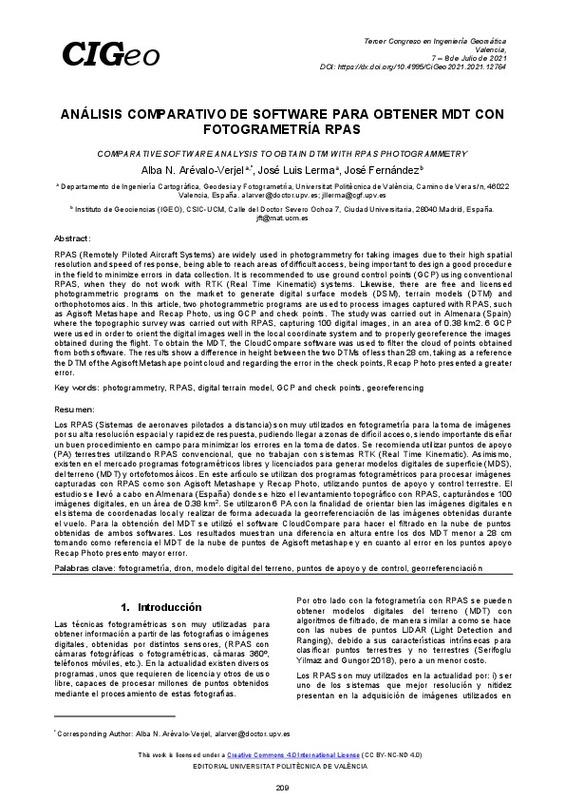JavaScript is disabled for your browser. Some features of this site may not work without it.
Buscar en RiuNet
Listar
Mi cuenta
Estadísticas
Ayuda RiuNet
Admin. UPV
Análisis comparativo de software para obtener MDT con fotogrametría RPAS
Mostrar el registro completo del ítem
Arevalo Verjel, AN.; Lerma García, JL.; Fernández, J. (2021). Análisis comparativo de software para obtener MDT con fotogrametría RPAS. En Proceedings 3rd Congress in Geomatics Engineering. Editorial Universitat Politècnica de València. 209-215. https://doi.org/10.4995/CiGeo2021.2021.12764
Por favor, use este identificador para citar o enlazar este ítem: http://hdl.handle.net/10251/174689
Ficheros en el ítem
Metadatos del ítem
| Título: | Análisis comparativo de software para obtener MDT con fotogrametría RPAS | |
| Otro titulo: |
|
|
| Autor: | Arevalo Verjel, Alba Nely Fernández, José | |
| Entidad UPV: |
|
|
| Fecha difusión: |
|
|
| Resumen: |
[EN] RPAS (Remotely Piloted Aircraft Systems) are widely used in photogrammetry for taking images due to their high spatial
resolution and speed of response, being able to reach areas of difficult access, being important ...[+]
[ES] Los RPAS (Sistemas de aeronaves pilotados a distancia) son muy utilizados en fotogrametría para la toma de imágenes
por su alta resolución espacial y rapidez de respuesta, pudiendo llegar a zonas de difícil acceso, ...[+]
|
|
| Palabras clave: |
|
|
| Derechos de uso: | Reconocimiento - No comercial - Sin obra derivada (by-nc-nd) | |
| ISBN: |
|
|
| Fuente: |
|
|
| DOI: |
|
|
| Editorial: |
|
|
| Versión del editor: | http://ocs.editorial.upv.es/index.php/CIGeo/CiGeo2021/paper/view/12764 | |
| Título del congreso: |
|
|
| Lugar del congreso: |
|
|
| Fecha congreso: |
|
|
| Código del Proyecto: |
|
|
| Agradecimientos: |
|
|
| Tipo: |
|









